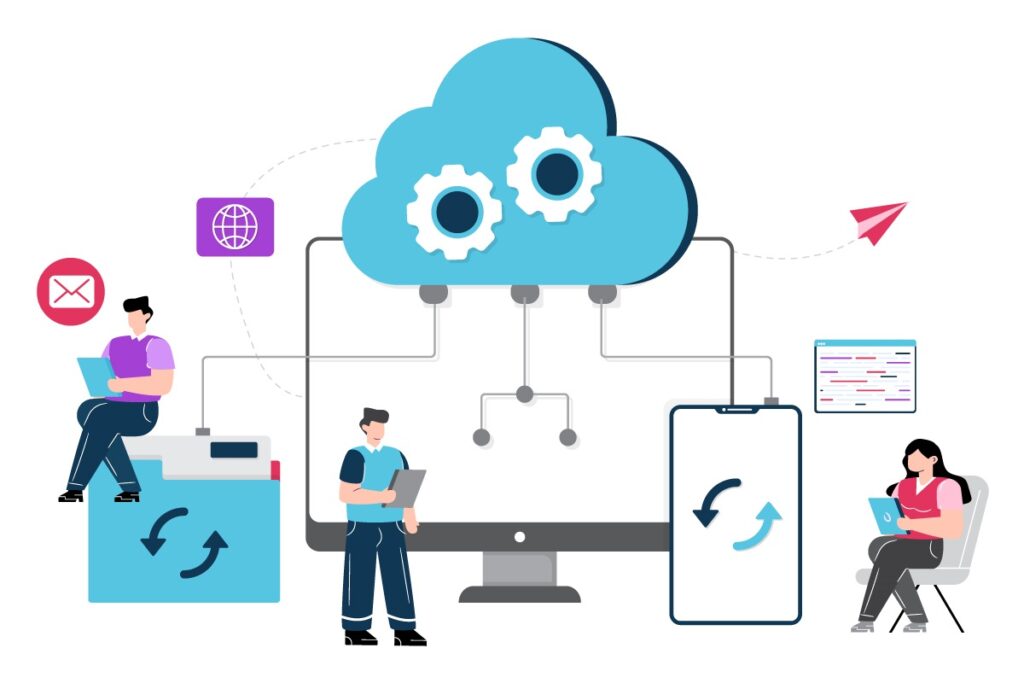Cloud Performance Management: Definition, Process, and Tools
Cloud Performance Management: Definition, Process, and Tools
Before learning about Cloud Performance Management, let’s first understand what a cloud system is and cloud performance.
A cloud system is often used to describe anything hosted on the internet. Now, what does that mean? Rather than keeping the data on the local device, you can put it online using a hosting service. These hosting service providers provide private spaces to keep the data safe.
Besides that, it gives you the advantage that you can access the data from anywhere in the world – all you need is the internet.
And even if you lose your local device, the data remains available on the cloud.
These cloud systems’ performance depends on multiple metrics, such as:
- Uptime
- Input/Output operations/second
- Caching
- Autoscaling
- Filesystem performance
- Security
- CPU Utilization
- Memory Utilization
- Latency
- The Error Rate
- Swap Usage
- Mean Time Between Failure
- Mean Time to Repair
Besides these metrics, there could be many other factors on which the performance depends. However, we won’t be discussing them here, rather, we’ll focus on different aspects of cloud performance management.

What is Cloud Performance Management?
Cloud performance management is the process by which the performance of the cloud is rated against various metrics, such as we mentioned above.
The aim of cloud performance management is to evaluate the cloud system’s performance and find room for improvement.
Primarily, cloud performance management allows the investigation of the data journey from the client’s local device to another location via the web and how it is stored in the cloud storage system.
It is generally accepted that the ability to collect metrics from providers such as Amazon EC2 is called cloud performance management. However, cloud performance management is much more than this, which we will explore in this article.
Various Perspectives of Cloud Performance Management
There are three perspectives associated with cloud performance management, which are mentioned below. Each perspective has its own requirements that we are going to explore now.
The Deployment Perspective
The focus of this perspective lies on the location from where cloud performance management is carried out. Therefore, it’s cloud performance management FROM the cloud. Here, you can monitor the cloud performance of applications from the cloud irrespective of the fact that whether they are on-premises, in a public/private cloud, or placed in a hybrid manner.
The biggest advantage of this perspective is that you can use the service without needing initial hardware or software costs. Also, there’s no need for additional software or hardware for regular cloud performance management.
Another major benefit is its ability to do a quick fix when there are performance issues with any of the mission-critical applications.
The Cloud Consumer Perspective
When you put an application on a private or a public cloud, you can use this perspective to monitor their performance. Whenever there’s a poor performance, such as low uptime or high latency, you can learn about the reason for it. This perspective is useful for cloud performance management “OF” the cloud. With one single management console, you can monitor the performance of on-premises as well as cloud apps.
The Cloud Service Provider Perspective
When you are a cloud service provider, you provide hosting space to your customers. Therefore, it’s your duty to ensure that your customers don’t face any issues while using the cloud as a service.
From a service provider’s perspective, you don’t only need to find out the solution to issues. You also need to improve efficiency to get the maximum value of the cloud investment. For instance, you can learn how to increase the number of cloud users without compromising the speed. This perspective is called cloud performance management “FOR” the cloud.
The Three-Step Plan for Cloud Performance Management
One of the best ways to enhance cloud performance lies in this three-step plan, which we are going to share here:
Start the Cloud Performance Management Logically, Not Physically
At the initial level, when you define the macro and micro requirements, start to work from the abstract and move towards the physical level. Based on your business needs, you need to pick up the tools. When it comes to enhancing cloud performance, you must focus on learning about the core hindrances in performance rather than understanding and evaluating the tools.
Considering Cloud Performance Management’s Impact on Performance
One must know that cloud performance management can itself impact the performance of cloud systems. That’s because the software agents and other aggressive activities occupy a huge portion of the CPU.
These can be moved to separate machine instances, and one can compromise with the invasive activities to get real-time performance data.
With the help of real-time performance data, you can correct the cloud performance.
Ongoing Improvement
After getting started and getting real-time performance data, you need to continuously improve cloud performance management. If you haven’t updated your cloud performance management strategies and tools, you need to consider the better options available.
Then, you need to check for issues continuously. That means there’s no end to this, but you can perform it on a weekly basis. We can’t achieve the highest level of cloud performance management, but it’s possible to improve it continuously.
NetSuite for Cloud Performance Monitoring
NetSuite Suite Cloud Application Performance Management tool is the best way to learn about production accounts. The APM tool offers you a well-designed dashboard that gives information regarding numerous metrics. Besides that, NetSuite makes it easier to understand the insights and identify the pattern using visual elements.
With the help of Cloud Application Performance Management, you can prevent any bottlenecks as you can take actions based on the insights. It suggests how you can optimize the customization and align it to the business needs using the insights at every stage of the software.
Rather than providing you with the overview, it gives you the exact areas where improvement can take place.
Benefits of NetSuite SuiteCloud Platform Performance Monitoring
- The application helps to keep the maximum uptime and makes it possible for the users to make the most out of it, improving the overall productivity of employees.
- You can learn about the overall health of the production accounts easily through the interactive dashboard, providing insights about the key metrics.
- It allows you to identify the root cause of issues through its analytics and helps you save time for problem identification.
- It helps you to make decisions regarding cloud applications, supported by predictions driven by in-depth data analytics.
Features of NetSuite SuiteCloud Platform Performance Monitoring Features
- Get real-time information regarding the performance through its visual and insightful dashboard.
- You can go through the root cause of different performance issues using the interactive drill down.
- It has selectable monitoring tiers that can identify the areas that require your attention.
Cloudiotech Performance Monitoring Services
Cloudiotech has experience setting up NetSuite SuiteCloud Platform Performance Monitoring tool for various businesses in different domains. Their requirement differs per the tools they use, the business domain, the business size, and several other factors.
Cloudiotech customized the NetSuite SuiteCloud Platform Performance Monitoring tool based on various factors and provided businesses with a ready-to-use application to detect issues and errors right away.
We also provided them with training to identify the problems and areas of improvement using the interactive dashboard. We provided them with the learning of how they can understand various metrics and use them to identify the root cause of the problem.
If you are migrating from any other application, we can also help you move your data to the NetSuite application without a hitch. Apart from that, we also offer ongoing support in case you need to customize the tool continuously or if there are ongoing additions to your cloud.
It is also possible to get support in the form of on-site resources, which will guide your employees at every stage of using NetSuite SuiteCloud Platform Performance Monitoring.
Conclusion
In this article, we learned about cloud performance management and why it is becoming more important each day. We also explore the three different perspectives of cloud performance management.
Besides that, we also made you familiar with the three-step plan for cloud performance management. We suggest that you apply this plan using the NetSuite SuiteCloud PPM. It helps to provide a complete understanding of the cloud performance, what are the errors, and where there is room for improvement.
Cloud Performance Management: Frequently Asked Questions
Cloud application performance management, also known as cloud APM, is the process used to keep a check on resources that support the application’s performance placed on various cloud types: public, private, and hybrid.
Cloud performance monitoring is the process used to quantify and analyze the performance of applications and services run using the cloud.




